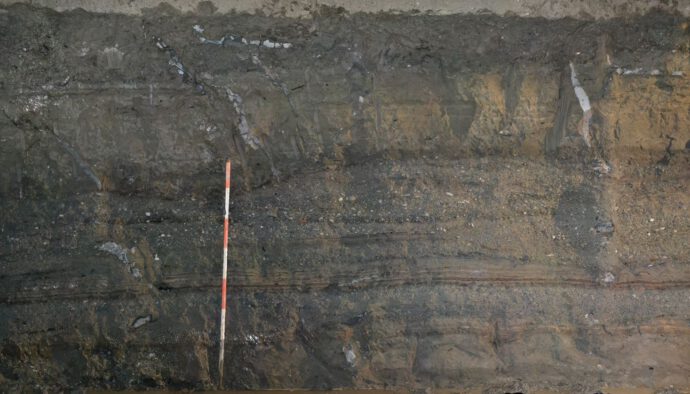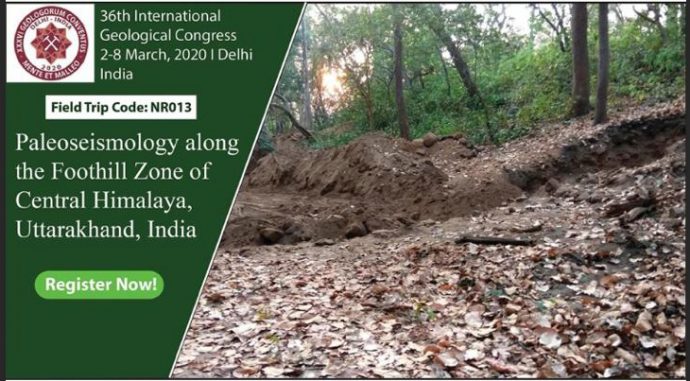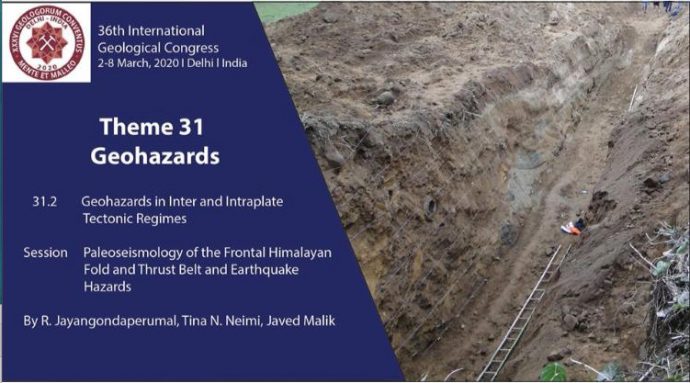– Focus: Mexican Pacific coast – Subduction Zone
– Responsibilities: Field and lab research on coastal geomorphology and tectonic deformation, or/and earthquake, and tsunami geology
– Qualifications: Recent Ph.D. in earth sciences, desirable background in either coastal geomorphology, earthquake geology, sedimentology, Quaternary dating, microfossils analytical techniques
Posts in the category » Uncategorized « ( 60 Posts )
-
Postdoctoral Research position in Coastal Tectonics/Paleoseismology/Active Tectonics/Tsunami Deposits at UNAM, Mexico
2023-12-21 | in Uncategorized -
Looking for the 2023 trenchiest trench pictures
2023-07-26 | in UncategorizedHey paleoseismicity nerds!
At the wonderful Inqua meeting in Rome I saw plenty of presentations and posters with trench pictures. After the first edition in 2022, it’s time to look for the trenchiest trench pictures of 2023. Here’s what you need to do:
- Take a break from your too-serious-work
- Open the folder with all the field photos
- Choose the best/funniest/strangest ones
- Smile
- Post them on Twitter and tag @GingerFault or send me an email since the bird app is quickly agonizing.
This year categories include “trench with a view”, “the devil is in detail”, “holy cow!”, “trench mindfulness” plus other random stuff which I cannot reveal right now since I still have to figure them out.

-
New papers on paleoseismology, active tectonics, and archaeoseismology (Mar 2023)
2023-03-01 | in Paper, UncategorizedBesides the classical paleoseismology studies in today’s list, we have some papers that deal with secondary and cascading effects of earthquakes, such as landslides and diseases, and interesting new findings on short term and long-term tectonic geomorphology. Enjoy reading!
more -
INQUA project EDITH – Kickoff meeting on 14-16 April 2021
2021-03-26 | in UncategorizedProject EDITH runs under the umbrella of INQUA’s TERPRO commission and the Int’l Focus Group TPPT (Terrestrial Processes Perturbed by Tectonics). EDITH proposes to organize and facilitate annual meetings with a wide range of experts in earthquake geology, paleoseismology, geodesy and tectonic geomorphology to gain a better understanding of the earthquake cycle with the final aim to provide constraints for future new seismic hazard assessment (SHA) geologically-based models. The kickoff meeting has now been scheduled to 14-16 April, 2021 and will be held via Zoom.
more -
Environmental Effects of the 23 June, 2020, M 7.4, Oaxaca, Mexico Earthquake
2020-06-27 | in UncategorizedOn 23 June, 2020, a magnitude 7.4 subduction earthquake struck western Mexico and let the earthquake early warning sirens sound in the capital. Reportedly, ten people lost their lives and thousands of houses were damaged in Oaxaca. Our colleagues Magda Velázquez-Bucio, Sabina Porfido, and Alessandro Michetti have put together a report on the Earthquake Environmental Effects of this event in English and Spanish:
more -
When the fault rings twice: repeated ruptures on the same fault stretch
2019-11-28 | in Uncategorized | 3 responsesThe recent publication of a paper on the Weitin Thrust (Papua New Guinea) by Chen, Milliner and Avouac (Fig. 1) gave me the opportunity to dig out and look back to some notes I wrote few months ago. Chen et al. use optical image correlation to document coseismic surface ruptures along the Weitin Thrust occurred in a Mw 8.0 event in 2000 and in a Mw 7.7 event in 2019. The ruptures overlap along a 20-km long portion, with 3-4 m of slip (Fig. 2).
more -
We mourn the passing of Prof. Dr. Victor Hugo Garduño Monroy
2019-10-17 | in UncategorizedDear colleagues,
It is with great sadness that we received note from the passing of our dear colleague Victor Hugo Gorduño Monroy.
Victor was a close friend to many of us and an outstanding person in the Mexican scientific community. He authored a great number of publications on the geology of Mexico, on tectonics, volcanism, and hazards. His work did not only advance geosciences, but also had huge impact on society. He was tireless in helping to raise the awareness for disasters and to promote geoscience in the public. We will never forget his enthusiasm and his dedication in the field.
He had the leading role in geosciences at the Michoacan University of San Nicolás de Hidalgo and taught hundreds of students during his career.
Victor organized the first PATA days outside Europe in November 2012 in Morelia in commemoration of the 1912 Acambay Earthquake, which was an absolute pleasure and a great success.
Our thoughts are with his family and with everyone who worked closely with him.
The Michoacan University of San Nicolás de Hidalgo released the following letter of condolence:
El día de hoy sufrimos la pérdida de una de nuestras más sólidas columnas institucionales. Informamos con profunda tristeza que el Dr. Víctor Hugo Garduño Monroy falleció esta mañana y con él perdimos a nuestro Líder Académico y Fundador de la Maestría en Geociencias y Planificación del Territorio y del Instituto de Investigaciones en Ciencias de la Tierra. El Dr. Garduño fue un incansable investigador de la Geología de nuestro Estado y del Occidente de México. Formador profesional de centenares de estudiantes a nivel profesional y posgrado. Ganador de la Presea José María Morelos y Pavón y Primer Investigador en Obtener la Presea Vasco de Quiroga en nuestra querida Universidad Michoacana de San Nicolás de Hidalgo. Hoy se fue uno de los mejores investigadores de nuestra Universidad, de nuestro Estado y de nuestro País. Siempre será recordado por el cariño a su profesión, a sus estudiantes y compañeros. Descanse en Paz.

Victor (right) with his friends and colleagues during the 2012 PATA Days in Morelia, Mexico. -
Landslides triggered by multiple earthquakes – a Matlab code
2019-09-25 | in Software and Applications, Uncategorized | one responseModerate to strong earthquakes commonly produce secondary effects (landslides, liquefaction, tsunamis), which worsen the impact of the seismic event, both during the emergency and recovery phases.
Landslides can be triggered by events of M above 5 or so, and stronger events can produce thousands of landslides. Landslide inventories were compiled for dozens of events and the relations between Mw and maximum distance or area affected by landslides have been analyzed (e.g., Keefer, 1984; Rodriguez et al., 1999). On the other hand, the total area affected by landslides is one of the metrics used to assign the ESI intensity (Environmental Seismic Intensity; Michetti et al., 2007).
more -
Hokudan 2020 International Symposium on Active Faulting, 13-17 January, Awaji, Japan
2019-09-16 | in UncategorizedThe Hokudan 2020 International Symposium on Active Faulting will take place from 13-17 January in Awaji City, Awaji Island, Japan. The symposium is held every five years. The 2020 event commemorates the 25th anniversary of the 1995 Kobe earthquake. All important information on this meeting is available here: https://home.hiroshima-u.ac.jp/kojiok/hokudan2020.html
This event is supported by INQUA – the International Union for Quaternary Research and its TERPRO commission. For more information, please contact Koji Okumura (kojiok@hiroshima-u.ac.jp) or Shinji Toda (toda@irides.tohoku.ac.jp).
Deadline for abstract submission is 1 December, 2019.
-
Paleoseismology field trip and theme session at the 36th International Geological Congress – IGC, Delhi
2019-09-06 | in UncategorizedDuring the 36th IGC in Delhi there will be a symposium on “31.2 Paleoseismology of the Frontal Himalayan Fold and Thrust Belt and Earthquake Hazards” in the Geohazards Theme 31. Abstract submission is free until 15th Sept. 2019 and open until 15th Oct. 2019.
There will also be a field trip “Paleoseismology along the Foothill Zone of Central Himalaya, Uttarakhand, India” from 25-29 Feb. 2020, Field Trip Code NR013.


